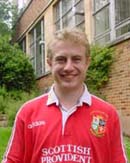Investigating the generation, characterisation and structure of biliquid foams

Stuart Hicks (previous student, left the group in 2005)
Biliquid foams are unique and intriguing systems believed to be structurally similar to foams, consisting of colloidal particles called aphrons (fig. 1), although the actual structure is unknown. A distinction is that the gaseous phase is substituted by a liquid phase, and these systems were first reported by Sebba [1]. Potential uses of these biliquid foam systems include personal care products, soil remediation [2], and controlled release of actives [3]. However despite the broad range of potential applications, little has been done to clarify Sebba's proposed structure. Indeed authors have proposed that these systems are essentially high-internal-phase-ratio-emulsions (HIPRE) [4]. A variety of biliquid foams have been created to study affects such as surfactant identity and concentration on the system, and to map portions of the phase diagram for this complex system. Light scattering and optical microscopy have been used to study some structural details, and these techniques have been complemented with SANS, and PFG-NMR to attempt to test Sebba's proposed structure.

A dispersed phase (A - usually oil) is surrounded by a contained layer of water (B) which is separated from the continuous phase (C - usually water) by a mixed surfactant bilayer (ionic and non-ionic).
References
- F. Sebba, J. Colloid Interface Science, 40 (3), (1972) 468
- W. Vidrine et al., Colloids Surf., A, 175 (3), (2000) 277
- D. Wheeler, PCT W/O 99/05229
- H. Princen, Langmuir, 4, (1988) 486
Sponsorship
![]()

This work is supported by the EPRSC and Disperse Technologies through the IMPACT Faraday scheme.